Agra-Jaipur
Rajasthan (Jaipur), Agra, Fathepur Sikri - August 2004
We spent our holiday 2004 roaming around main sites in Indian states of Rajastan (Jaipur) and Uttar Pradesh (Agra, Fathepur Sikri). Going through the towns by car was for me like getting back many years ago to my student´s years when I visited India for the first time (1970). Nothing much seemed to change when observing the traffic. People dragging heavy loads on carts, rikshaws mostly not motorized but human powered, multitude of people clad in variety of clothes, cows and camels contributing to the chaos. Easy to imagine even the life of population under the Mughals. As monsoon had not finished yet, we were also witnesses of flooded streets and houses accepted stoically by their owners.
The orthography of the title of the mighty rulers of this region is disputed - Wikipedia calls them Mughals, Alexander Rutherford in his pentalogy (see information at the end) uses the name Moghuls, in Czech language they are called Moguls. I have decided to let it open - just be aware that we are talking about the same dynasty whatever spelling is used.
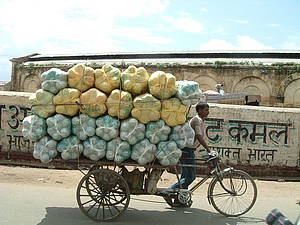
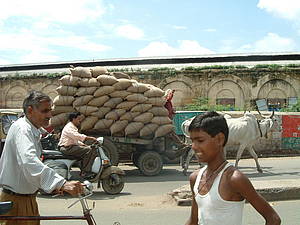
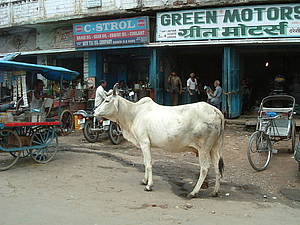
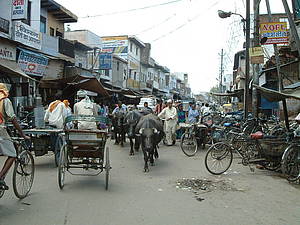
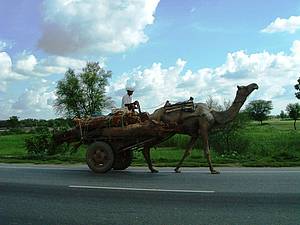
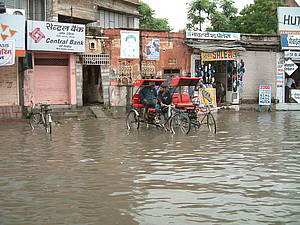
In the early 16th century, northern India, being then under mainly Muslim rulers, fell to the superior mobility and firepower of the Mughals. Agra and Fathepur Sikri (now in the state of Uttar Pradesh) are very much connected with this Mughal tradition.
Mughal´s ancestors date back to nomadic conqueror Genghis Khan and famous Timur known in Europe as Tamburlaine. The dynasty was founded by King Babur, who conquered Kabul and parts of today´s northern India. The next on the throne were his son Hamayun and further Hamayun´s son, the third Moghul Emperor Akbar. Akbar ascended the Mughal throne at the age of 14. During his reign he enlarged his kingdom of Northern India, Afghanistan and Persia, and although he was a Muslim he had Hindus in his government. Among his three hundred wives there were some Hindus as well. He was known for his princely manners, he loved literature and art, and encouraged both. He was promoting religious tolerance to all faiths, which philosophy was taken over also by his son Jahangir.
Jahangir built the Shalimar Gardens in Kashmir, as well as many grand buildings and gardens in Lahore. He was the first Indian emperor to welcome an Englishman to the Mughal court - the Englishman Captain William Hawkins, who was trying to obtain permission from Jahangir to open a factory in India. Hawkins and Jahangir got on so well, that Hawkins stayed at the Mughal court more than six months and married a woman of Jahangir's choice. However, Jahangir only gave permission for an English factory to be set up at Surat seven years later, after much bribery and persuasion from the Company.
The most famous Mughal is probably Jahangir´s third son, Shah Jahan, the builder of Taj Mahal in Agra. Although the Mughal empire became largest under the rule of Shah Jahan´s son Aurangzeb (Alamgir), the wars in which he got involved all over were sucking the funds so much and the territory he had to defend was so big that during his reign there were already obvious signs of decline of Moghul´s power. His religious conservatism and intolerance undermined the stability of Mughal society as well. He was a builder of a small Taj Mahal Bibika and his reign was marked by the beginning of Maratha wars led by Maratha hero Shivaji. Aurangzeb expanded the empire to include almost the whole of South Asia, but at his death in 1707, many parts of the empire were in open revolt. Aurangzeb's son, Shah Alam, repealed the religious policies of his father, and attempted to reform the administration, however, it was too late. After his death in 1712, the Mughal dynasty sank into chaos and violent feuds. In the year 1719 alone, four emperors successively ascended the throne.
By the mid-18th century, the Marathas conquered several Mughal provinces from the Deccan to Bengal. The internal dissatisfaction with Mughals was caused by the increasing weakness of their administrative and economic systems, which led to the declaration of independence by varius Nawabs, by the Nizam of Hyderabad and the Shah of Afghanistan. Breaking up of the Moghul Empire continued for the next 150 years, until, after a crushed Indian rebellion of 1857, the last Mughal Bahadur Shah II was tried by the British for treason and exiled to Rangoon by the British government who then assumed formal control of the country and the last remnants of the empire were taken over by the British Raj.
Fathepur Sikri
Fatehpur Sikri was founded in 1569 by the Emperor Akbar, and served as the capital of the Mughal Empire from 1571 to 1585. It is one of the best preserved collections of Mughal architecture in India. Akbar took a great interest in building of Fatehpur Sikri and probably also dictated its architectural style. Seeking to revive the splendours of Persian court ceremonial made famous by his ancestor Timur, Akbar planned the complex on Persian principles. But the influences of his adopted land came through in the typically Indian embellishments. The imperial Palace complex consists of a number of independent pavilions arranged in formal geometry on a piece of level ground, a pattern derived from Arab and central Asian tent encampments. In its entirety, the monuments at Fatehpur Sikri thus reflect the genius of Akbar in assimilating diverse regional architectural influences within a holistic style that was uniquely his own.
The Imperial complex was abandoned in 1585, shortly after its completion. The reasons for this are not completely clear, but probably insufficient water for all the fountains, creeks and human consumption as well and its proximity to the Rajputana areas which were in increasing turmoil contributed to that decision. Thus the capital was shifted to Lahore, which Akbar considered to be a more stable part of the empire, before he moved back to Agra in 1598.
We visited Fatehpur Sikri on a rainy day. But it made a great impression on us also thanks to interesting and deep explanations by our professional guide. We were especially amazed to see the symbols of all major India´s faiths – Islam, Hinduism, Buddhism and Christianity carved into an octagonal pillar in the middle of Akbar´s Hall of Private Audience, an undoubted proof of a religious tolerance unheard of in that time – most countries in Europe of 16th and 17th century, including Germany, Bohemia, the Netherlands, France, England and others, were at the same time shattered by religious wars (only one example - 1572 was the year when the French Huguenots were murdered during Bartholomew´s night).
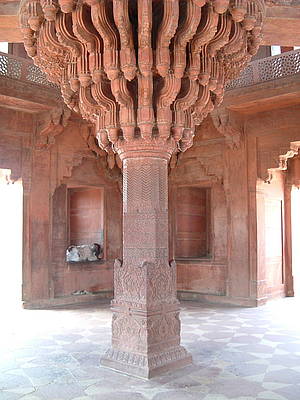
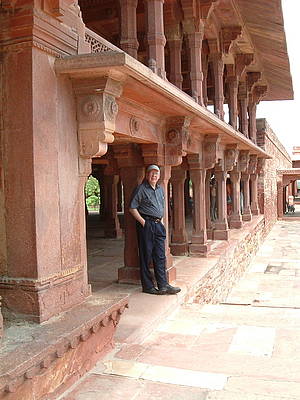
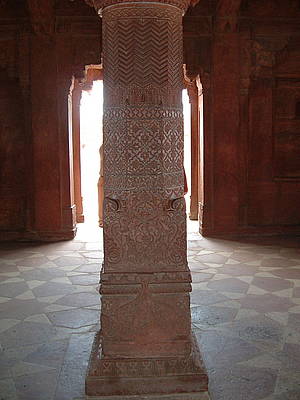
Fatehpur Sikri
Agra
Agra Fort is standing on the banks of river Jamuna, Great Mughals - Babur, Hamayun, Akbar, Jahangir, Shah Jahan and Aurungzeb - governed from there. It contained the largest state treasury and mint (including the famous diamond Koh-I-Noor), was visited by foreign ambassadors and travelers from all over the world. Agra Fort is an interesting mix of Hindu and Islamic architecture. In fact, some of the Islamic decorations feature sinful images of living creatures – dragons, elephants and birds, instead of the usual patterns and calligraphy seen in Islamic surface decoration. There is an interesting story connected to the throne of Mughal Jahangir, which is still standing in the same place as in his lifetime.
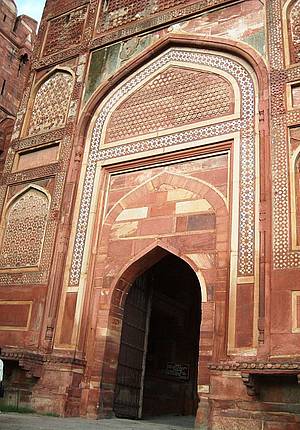
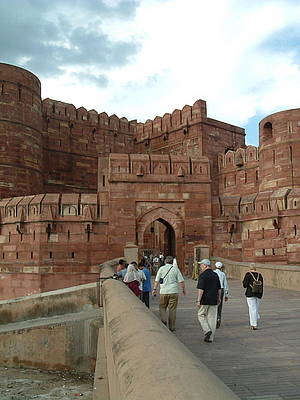
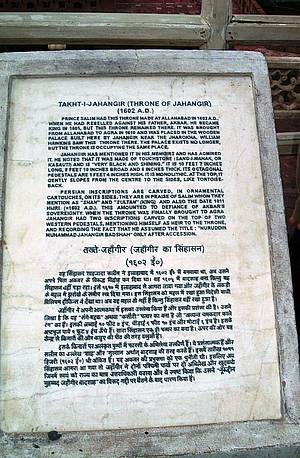
Agra Fort
Taj Mahal, “crown of the palaces", is a white marble mausoleum built by Emperor Shah Jahan in memory of his third wife, Mumtaz Mahal. Taj Mahal combines elements from Islamic, Persian, Ottoman Turkish and Indian architectural styles. Soon after the Taj Mahal's completion, Shah Jahan was deposed by his son Aurangzeb and put under house arrest at nearby Agra Fort. Upon Shah Jahan's death, Aurangzeb buried him in the mausoleum next to his wife. The monument was declared UNESCO World Heritage Site in 1983.
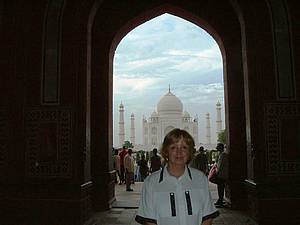
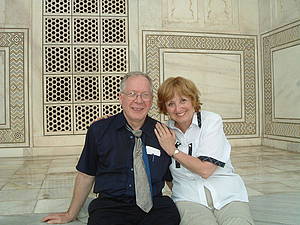
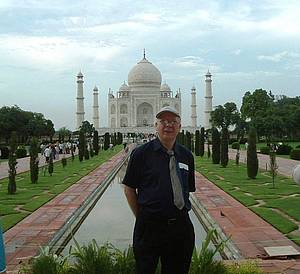
Taj Mahal Tomb
Jaipur
The capital of Rajasthan, Jaipur, enchanted us. We were staying in Ram Bagh Palace, the construction of which was started by the Queen of Jaipur in 1835 and extended and finished to its full beauty in 1931. When the Maharajas family felt that the maintenance of the building and its extensive gardens became too costly, they decided to make it to one of the most luxurious hotels in India operated by Taj. The Palace with wide terraces, spacious corridors and magnanimous rooms beware the impression of imperial legacy for which it became unique. From the sites of Jaipur the most interesting ones were the Palace of Wind, Observatory and Amber Palace.
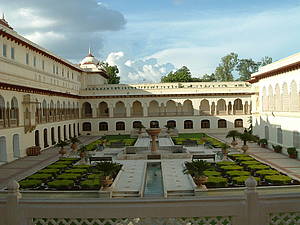
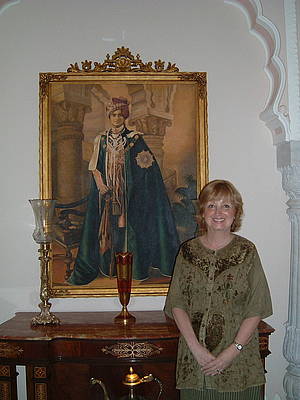
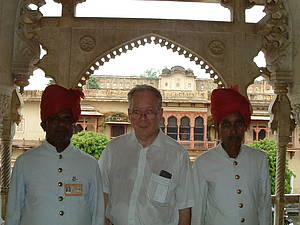
Rambagh Palace
Hawa Mahal or the Palace of Wind was built 1799 by Maharaja Sawai Pratap Singh. It has a remarkable Rajput Style architecture made of red and pink sandstone. Its unique five-storey exterior reminds a honeycomb of the beehive containing 953 small windows called jharokhas, each with intricate decorations. It was originally conceived with the aim to enable ladies of the royal household to watch the everyday life and royal processions without being seen since they had to observe strict "purdah" (face cover). Hawa Mahal forms a part of the City Palace
complex and extends to the Zenana (harem chambers). City Palace which includes the Chandra Mahal and Mubarak Mahal palaces was the seat of the Maharaja of Jaipur, the head of the Kachwaha Rajput clan. The Chandra Mahal palace now houses a museum but the greatest part of it is still a royal residence. We could see two huge sterling silver vessels, aroung one and half meters high, with capacity of 4000 litres each and weighing 340 kilograms which are displayed there. They were made from 14000 melted silver coins without soldering. These vessels were specially made by Maharaja Sawai Madho Singh II, who was a highly pious Hindu, to carry the water of the Ganges to drink on his trip to England in 1901 for Edward VII's coronation as he was finicky about committing religious sin by consuming the English water.
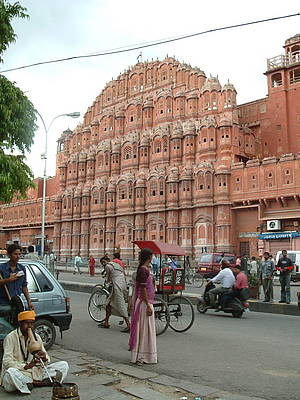
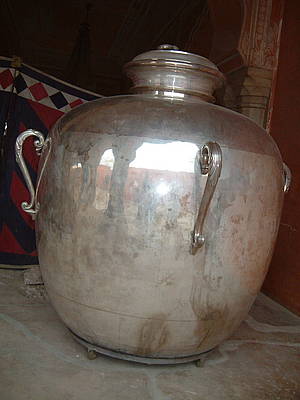
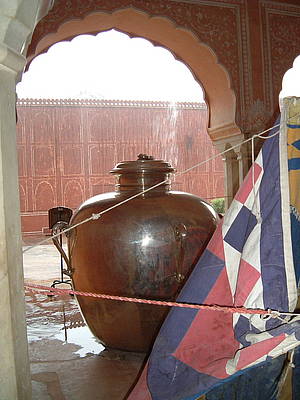
Palace of the Winds, Silver Vessels in the City Palace
The Jantar Mantar or observatory is an equinoctial sun-dial intended to measure the time of the day and declination and movements of the Sun and other heavenly bodies. It is supposed to be correct to half a second – a miracle of science of that time. It is one of five similar achievements of astronomical science built in other cities in the first quarter of 18th century by Maharaja Jai Singh II.
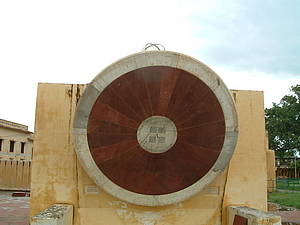
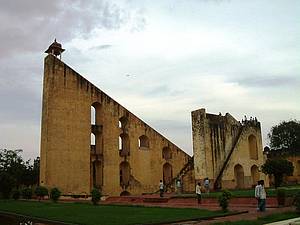
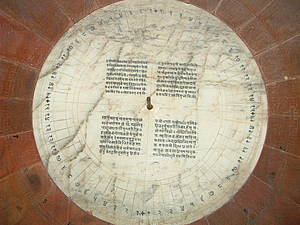
Jantar Mantar
Amber Fort, built in 16th century by Maharaja Man Singh sprawls on the hillside. Its construction was started by Raja Man Singh but completed only by his descendant Jai Singh. Amber is the classic romantic Rajasthan fort palace. Today it is nothing but a reflection of the glorious past of the fierce Kachwaha Dynasty that ruled over this region from 12th to 18th century. The Amber fort is built in the red sandstone and white marble; the interior is a virtual paradise and painted scenes of hunting and wars adorn the walls along with precious stones and mirrors set into the plaster. To get to the Amber Fort, we had either to climb on foot or use one of the elephants from the waiting herd – we preferred the elephant. Below the fort, the charmers playing flute to dancing cobras were to be seen as well.
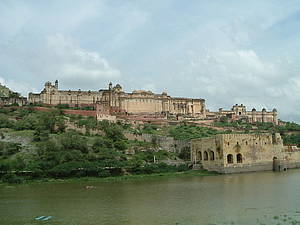
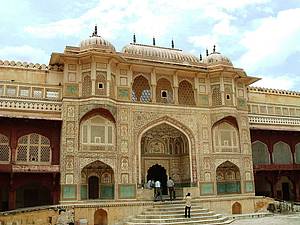
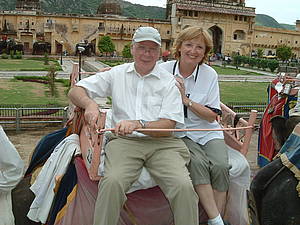
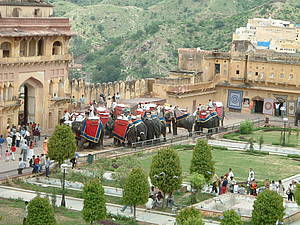
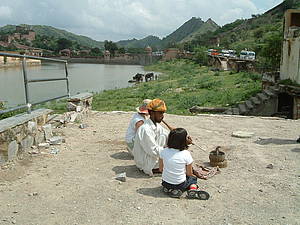
Amber Palace
The most interesting information about the history of this part of India is to be obtained in series of novels by Alexander Rutherford called the Empire of the Moghul. It was a brutal world with a lot of violence, wars, torture, feuds and treason, even among former friends and the nearest family. It was a fight for power and wealth where brothers did not consider each other´s rights, where a son was ready to imprison his own father and father was prepared to kill his rebellious son. But through all this you can read also the stories of love, devotion, hesitation, doubts about the correctness of one´s own actions – all perfectly human as in our days. The historical background is researched and characters presented in such a way that all the Moghuls are becoming unforgettable. Raiders from the North evolve a story around Babur, who became from a small ruler of Ferghana ruler of Hindustan. Brothers at War tells story of his son Humayun who lost through his brothers much of the empire including Agra and Delhi, but with Persian help reconquered Kabul and Hindustan. Ruler of the World is about famous Akbar whom I have already mentioned above. Tainted Throne brings on the throne his son Jahangir who has to fight against his enemies and opium addiction as well. The Serpent´s Tooth is about the Taj Mahal Builder Shah Jahan.
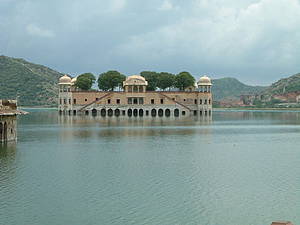
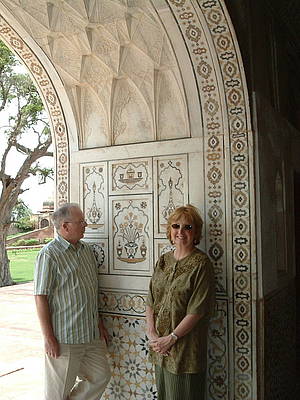
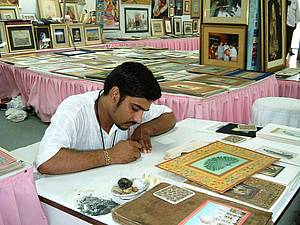
Water Palace Jaipur, Taj Mahal decorations, painter in the City Palace Jaipur


